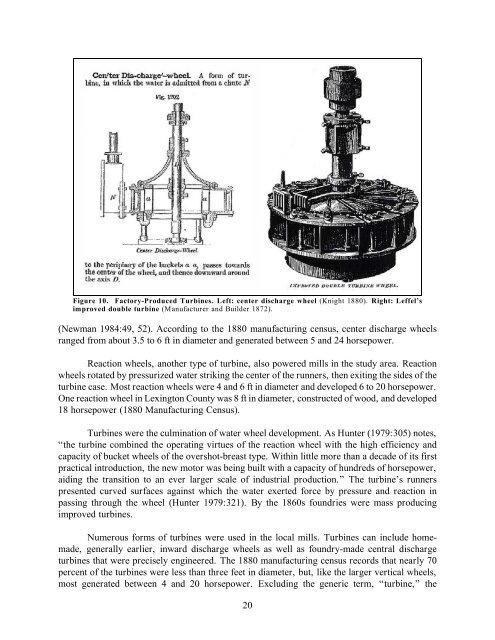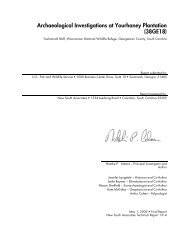Mills in the Upcountry: a Historic Context, and a Summary of a Mill ...
Mills in the Upcountry: a Historic Context, and a Summary of a Mill ...
Mills in the Upcountry: a Historic Context, and a Summary of a Mill ...
Create successful ePaper yourself
Turn your PDF publications into a flip-book with our unique Google optimized e-Paper software.
Figure 10. Factory-Produced Turb<strong>in</strong>es. Left: center discharge wheel (Knight 1880). Right: Leffel’s<br />
improved double turb<strong>in</strong>e (Manufacturer <strong>and</strong> Builder 1872).<br />
(Newman 1984:49, 52). Accord<strong>in</strong>g to <strong>the</strong> 1880 manufactur<strong>in</strong>g census, center discharge wheels<br />
ranged from about 3.5 to 6 ft <strong>in</strong> diameter <strong>and</strong> generated between 5 <strong>and</strong> 24 horsepower.<br />
Reaction wheels, ano<strong>the</strong>r type <strong>of</strong> turb<strong>in</strong>e, also powered mills <strong>in</strong> <strong>the</strong> study area. Reaction<br />
wheels rotated by pressurized water strik<strong>in</strong>g <strong>the</strong> center <strong>of</strong> <strong>the</strong> runners, <strong>the</strong>n exit<strong>in</strong>g <strong>the</strong> sides <strong>of</strong> <strong>the</strong><br />
turb<strong>in</strong>e case. Most reaction wheels were 4 <strong>and</strong> 6 ft <strong>in</strong> diameter <strong>and</strong> developed 6 to 20 horsepower.<br />
One reaction wheel <strong>in</strong> Lex<strong>in</strong>gton County was 8 ft <strong>in</strong> diameter, constructed <strong>of</strong> wood, <strong>and</strong> developed<br />
18 horsepower (1880 Manufactur<strong>in</strong>g Census).<br />
Turb<strong>in</strong>es were <strong>the</strong> culm<strong>in</strong>ation <strong>of</strong> water wheel development. As Hunter (1979:305) notes,<br />
“<strong>the</strong> turb<strong>in</strong>e comb<strong>in</strong>ed <strong>the</strong> operat<strong>in</strong>g virtues <strong>of</strong> <strong>the</strong> reaction wheel with <strong>the</strong> high efficiency <strong>and</strong><br />
capacity <strong>of</strong> bucket wheels <strong>of</strong> <strong>the</strong> overshot-breast type. With<strong>in</strong> little more than a decade <strong>of</strong> its first<br />
practical <strong>in</strong>troduction, <strong>the</strong> new motor was be<strong>in</strong>g built with a capacity <strong>of</strong> hundreds <strong>of</strong> horsepower,<br />
aid<strong>in</strong>g <strong>the</strong> transition to an ever larger scale <strong>of</strong> <strong>in</strong>dustrial production.” The turb<strong>in</strong>e’s runners<br />
presented curved surfaces aga<strong>in</strong>st which <strong>the</strong> water exerted force by pressure <strong>and</strong> reaction <strong>in</strong><br />
pass<strong>in</strong>g through <strong>the</strong> wheel (Hunter 1979:321). By <strong>the</strong> 1860s foundries were mass produc<strong>in</strong>g<br />
improved turb<strong>in</strong>es.<br />
Numerous forms <strong>of</strong> turb<strong>in</strong>es were used <strong>in</strong> <strong>the</strong> local mills. Turb<strong>in</strong>es can <strong>in</strong>clude homemade,<br />
generally earlier, <strong>in</strong>ward discharge wheels as well as foundry-made central discharge<br />
turb<strong>in</strong>es that were precisely eng<strong>in</strong>eered. The 1880 manufactur<strong>in</strong>g census records that nearly 70<br />
percent <strong>of</strong> <strong>the</strong> turb<strong>in</strong>es were less than three feet <strong>in</strong> diameter, but, like <strong>the</strong> larger vertical wheels,<br />
most generated between 4 <strong>and</strong> 20 horsepower. Exclud<strong>in</strong>g <strong>the</strong> generic term, “turb<strong>in</strong>e,” <strong>the</strong><br />
20







